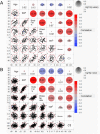Complement component C3 is associated with body composition parameters and sarcopenia in community-dwelling older adults: a cross-sectional study in Japan
- PMID: 38279167
- PMCID: PMC10821262
- DOI: 10.1186/s12877-024-04720-z
Complement component C3 is associated with body composition parameters and sarcopenia in community-dwelling older adults: a cross-sectional study in Japan
Abstract
Background: Chronic inflammation is a factor in the pathogenesis of sarcopenia, which is characterized by low muscle mass and reduced strength. Complement C3 is important in the management of the immune network system. This study seeks to determine the relationship between serum C3 levels and body composition and sarcopenia-related status in community-dwelling older adults.
Methods: Study participants were 269 older adults living in rural Japan. A bioelectrical impedance analysis device was used to measure body composition parameters including body mass index (BMI), body fat percentage, waist-hip-ratio, and appendicular skeletal muscle mass index (SMI). Muscle function was measured by handgrip strength and 6-m walking speed. The correlation coefficients for C3 level and measurements were calculated using Pearson correlation analysis. Participants were categorized into normal, pre-sarcopenia, dynapenia, or sarcopenia groups. Sarcopenia was defined according to 2019 Asian Working Group for Sarcopenia definition, dynapenia was defined as low muscle function without low muscle mass, and pre-sarcopenia was defined as the presence of low muscle mass only. The C3 threshold score for sarcopenia status was evaluated by receiver operating characteristic curve (ROC) analysis.
Results: Significant positive correlations were found between C3 and BMI, body fat percentage, and waist-hip ratio in both sexes, and further positive correlations with SMI were found in women. The relationship with body fat percentage was particularly strong. Body composition measurements (BMI, body fat percentage, and waist- hip ratio) and C3 levels were lowest in the sarcopenia group compared with the others. ROC analysis showed that the significant threshold of C3 for discriminating between the normal and sarcopenia groups was 105 mg/dL. Multiple logistic regression analysis showed that participants with C3 < 105 mg/dL had an odds ratio of 3.27 (95% confidence interval, 1.49-7.18) for sarcopenia adjusted by sex, age and body fat percentage.
Conclusion: C3 levels are suggested to be related to body composition and pathophysiological functions of sarcopenia. C3 is expected to become a useful biomarker for sarcopenia, for predicting the onset of the disease and for predicting the effectiveness of interventions.
Keywords: Body composition; C3; Complement; Older adults; Sarcopenia.
© 2024. The Author(s).
Conflict of interest statement
The authors declare that they have no competing interests.
Figures




References
-
- Statistics Bureau Home Page/Population Estimates Monthly Report (April 2023). https://www.stat.go.jp/english/data/jinsui/tsuki/index.html Accessed 18 Oct 2023.
-
- Tanimoto Y, Watanabe M, Sun W, Hirota C, Sugiura Y, Kono R, et al. Association between muscle mass and disability in performing instrumental activities of daily living (IADL) in community-dwelling elderly in Japan. Arch Gerontol Geriatr. 2012;54:e230–e233. doi: 10.1016/j.archger.2011.06.015. - DOI - PubMed
Publication types
MeSH terms
Substances
LinkOut - more resources
Full Text Sources
Miscellaneous

